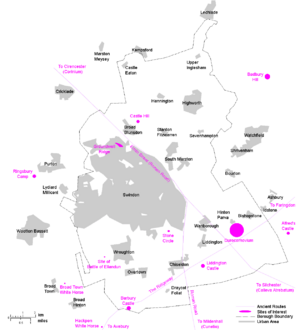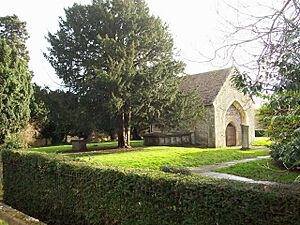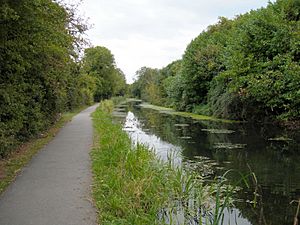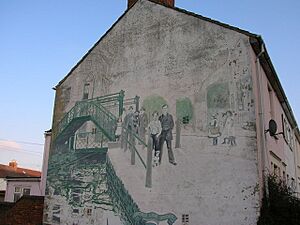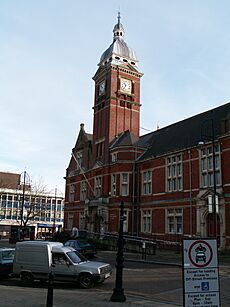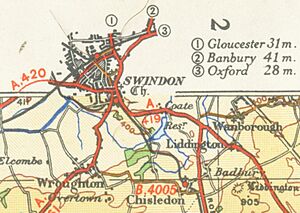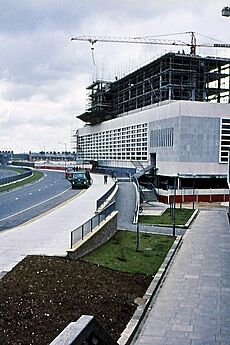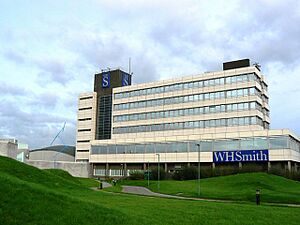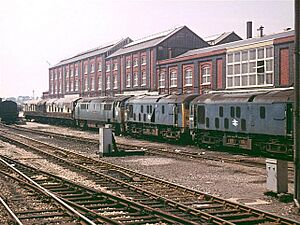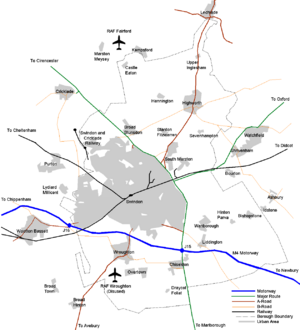History of Swindon facts for kids
Swindon is a town in Wiltshire, located in the South West of England. People have lived here since the Bronze Age. Swindon's location, about halfway between Bristol and London, made it a perfect spot for the Locomotive Factories of the Great Western Railway in the 1800s.
Swindon has grown a lot! In 1801, only 1,198 people lived here. By 2001, there were over 150,000 residents.
Contents
Early History: Before Records Began
The modern town of Swindon is built on and around a hill called Swindon Hill. It stands over 450 ft (140 m) above sea-level. This location was great for farming. It was near the Marlborough Downs and the Vale of White Horse, with access to the River Cole.
People lived around this hill in pre-historic times. While there isn't much proof of settlements directly on the hill, digs have found interesting things. Parts of Swindon Hill and the Old Town were used for quarrying stone.
Archaeologists have found Bronze Age items like tools and pottery. They also found Iron Age artifacts. These finds show that people lived and farmed here long ago.
Nearby, you can find ancient monuments and earthworks. These include Liddington Castle, Barbury Castle, Avebury, and the famous White Horses of Uffington and Marlborough.
Even older finds, from the Mesolithic period, have been discovered. These are mostly flint tools. The Coate Stone Circle is one of the few ancient stone settings that still exists. It's protected by English Heritage.
Roman Times in Swindon
A Roman town called Durocornovium was located east of Swindon, in what is now Wanborough. It existed from the 1st to 4th centuries. Swindon itself might have started as a small settlement linked to a Roman army camp.
The area that is now Swindon was important because two Roman roads met here. One went south from Cirencester towards Marlborough. The other went southeast to Silchester.
Swindon's quarries were busy during Roman times. They provided stone for fancy Roman villas. Clay from the Whitehill area (now West Swindon) was used to make special "Whitehill Ware" pottery.
In 1996, workers found buried walls of Roman buildings at Groundwell Ridge. This was a very important discovery! It included a hypocaust (an ancient under-floor heating system, like those in Roman bath houses). The site is now protected as a Scheduled Ancient Monument. It was even featured on the TV show Time Team in 2003.
Anglo-Saxon Swindon
When the Romans left Britain in the 5th century, their settlements near Swindon quickly faded away. The West Saxons, a Germanic group, took control of Swindon after the Battle of Beranburgh in 556. This battle was likely fought at Barbury Castle.
The West Saxons built a farming community on top of Swindon Hill. They lived in simple huts made of wood and plaster. Anglo-Saxon pottery and cloth found here show that people lived in the town throughout the 6th and 7th centuries.
The Anglo-Saxons gave many local places their names. The name "Swindon" itself might come from their words "Swine" (for pig) and "Down" (for hill). So, it could mean "Pig Hill"!
Medieval Swindon: Markets and Manors
Swindon is mentioned in the Domesday Book of 1086 as Suindone and Suindune. The land was divided into several parts. The largest part, called the manor of High Swindon, was later owned by William de Valence.
In 1259, the first recorded market was held in Swindon. This was a big step for the town's economy.
The oldest street in Swindon is Newport Street, dating back to 1346. Its name, Nyweport, meant "New Market". Some cellars of houses on this street might still be from that time!
By the 16th century, the Goddard family bought the manor of Swindon. At this time, Swindon's economy was mostly about farming. There were sheep farms, pigs, and cattle. Trades like tanners (who made leather) and woolmongers (who sold wool) were also important.
The 1700s: Growth and Roads
In 1705, a count showed about 600 people living in Swindon. The Goddard family, as Lords of the Manor, earned money from rent and taxes.
The main ways Swindon made money were from farming, livestock, and quarrying. The Purbeck Stone quarries were very active, providing stone for new buildings.
The first shops that weren't part of the market also appeared around this time. This meant Swindon was slowly moving away from just trading goods. Robert and Margaret Boxwell opened the first grocery store in 1705. They even imported tea and sugar!
The quarries were the biggest employers in 1701, with many stonecutters and laborers. Other jobs included bakers, butchers, innkeepers, tailors, and cobblers.
Roads and Tolls
Roads became more important with the growth of quarries and the new Turnpike Act of 1706. This act meant that the main roads into Swindon became toll roads between 1751 and 1775. You had to pay to use them!
Toll houses were set up on roads leading to nearby towns like Marlborough and Devizes. The amount you paid depended on your cart, how many horses you had, and the width of your wheels. Wider wheels caused less damage, so they were cheaper.
Roads were kept clean by auctioning off the right to collect "road scrapings" (like manure) to townspeople. This practice continued until at least 1846.
The Goddard Family: Lords of Swindon
The Goddard family was important in Swindon for a long time. They owned the manor from 1563 until the 20th century. Their estate included the area known today as The Lawns.
The last male Goddard, Major Fitzroy Pleydell Goddard, died in 1927. His widow left Swindon in 1931. During World War II, the Goddard family's manor house was used by British and American forces. It was damaged and later torn down in 1952. Today, The Lawns is a public park, with parts of the old estate still visible.
Swindon's Markets
Swindon's economy has always relied on land, farming, and livestock markets. The first market was held in 1259.
Even though a new cattle market was built in 1873 to try and boost sales, it eventually closed in the late 1980s. Today, there is no cattle market in Swindon.
The 1800s: Canals and Steam Power
The 1800s were a time of huge growth for Swindon. First came the Canals, and then the Railway. These changes made the town's population double from 1,198 in 1801 to 2,495 in 1841.
At the start of the 19th century, Swindon was still a small town on top of Swindon Hill. The areas we know as Coate, Walcott, and Rodbourne Cheney were just tiny hamlets.
Eastcott became the center of the "new" Swindon. The Wilts and Berks Canal Company built Swindon Wharf there. What is now Swindon town center was mostly farms and fields until 1840! A bridge built over the canal in 1806 later became the Golden Lion bridge, now in the middle of Swindon's main shopping area.
Purbeck Stone Quarries
From the mid-1600s to the late 1700s, Swindon's economy grew thanks to its Purbeck Stone quarries. This type of limestone had been used since Roman times.
The quarries slowed down in the late 1700s but became busy again when the Wilts and Berks Canal was built. Stone was used for the canal walls and buildings. Even though the railway later reduced stone transport by canal, the Great Western Railway buildings brought a new demand for Swindon stone. Quarrying stopped in the late 1950s. Today, Queens Park and Town Gardens are on former quarry sites.
The Canals Arrive
In 1775, a law allowed the building of the Wilts and Berks Canal. This waterway connected the Kennet and Avon Canal to the River Thames. It reached Swindon in 1804. The canal helped Swindon businesses and farmers move goods over a wider area.
In 1813, the North Wilts Canal was approved. It linked the Wilts and Berks Canal at Swindon to the Thames and Severn Canal. This canal had 9 miles (14 km) of waterway and twelve locks. It was finished in 1814.
A large reservoir was built at Coate in 1822. This 70-acre (280,000 m2) reservoir kept the canal full of water in the Swindon area.
However, the railways offered a faster and cheaper way to transport goods. By 1895, the canal was hardly used. It officially closed in 1914 and parts were filled in. You can still see parts of the canal in Swindon, and "Canal Walk" in the town center reminds us of its history.
Brunel, the Railway, and Industrial Swindon
In 1830, Swindon was still a quiet market town. But this was about to change with the arrival of the Great Western Railway.
In 1835, a railway was approved to run between London and Bristol. Isambard Kingdom Brunel was the Chief Engineer. The railway was originally planned to go through Savernake Forest, but the landowner objected. Swindon became the next best choice for the railway's main workshops.
The Goddard family, who owned land in Swindon, also didn't want the railway too close to their property. So, it was built a couple of miles further north.
The Railway Works
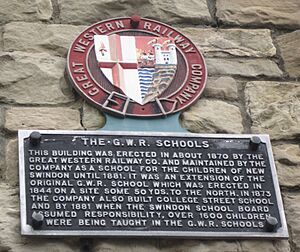
The railway's workshops, known as the Swindon Works, transformed Swindon. It grew from a small market town into a major "Railway Town." The population boomed, and the railway also provided important medical and educational facilities.
The Works eventually covered 320 acres (1.3 km2). It became the center of "New Swindon" and brought over 10,000 new residents in 50 years. At its busiest, it employed over 14,000 people! The main workshop, called the A Shop, was one of the largest covered areas in the world at 11.25 acres (45,500 m2).
Swindon Station

The railway passed through Swindon in early 1841. The Goddard Arms pub in Old Swindon was used as a temporary booking office. Passengers bought tickets there, which included a horse-drawn carriage ride down the hill to the tracks. Swindon railway station officially opened in 1842.
The Railway Village and New Swindon
The railway factory needed workers to live close by. Since Old Swindon was over a mile away, a "Railway Village" of 300 homes was planned in 1841. Stone from Swindon's quarries was used to build these homes. By 1853, 243 houses were finished, and the town's population was over 2,500.
This new town, called New Swindon, was separate from Old Swindon until 1900.
The 1900s: A Growing Town
1900–1910: One Swindon
On January 22, 1900, Queen Victoria signed a special document giving Swindon "Municipal Borough" status. This meant Old and New Swindon joined together into one town. This allowed them to combine their money and open an electrical power station in 1903.
Trams were introduced in September 1904, making it easier to get around. Sadly, in 1906, a tram accident occurred, killing five people.
The Wilts & Berks Canal continued to decline and was formally closed in 1914.
1910–1930: Changes and Growth
During this time, Swindon got its first cinemas, built along the tram routes.
Swindon Town F.C. (the local football team) did very well, reaching the semi-finals of the FA Cup twice.
In 1919, a flagpole war memorial caused riots because some people felt it was disrespectful. It was later replaced by a stone cenotaph in 1920.
The first council housing estate was built in Pinehurst. These new homes had modern features like electric lights and bathrooms. They also had a shopping center and a temporary school.
The local newspaper, the Swindon Advertiser, was bought in 1920 and became the Evening Advertiser.
In 1924, the GWR Railway Works had its highest number of employees ever: 14,369 people! King George V and Queen Mary even visited the works to see the famous "King George V" train being built.
After only 25 years, Swindon's trams were replaced by buses in 1929.
1930–1950: The War Years
Swindon got its first special Maternity Hospital in 1931. More cars meant a purpose-built car park was built behind the Town Hall.
Housing expanded again in the Old Town area between 1934 and 1935. New terraced houses were built in Walcot.
When World War II started in 1939, evacuees came to Swindon. Troops were stationed in churches and schools. The GWR Works became a war factory, making Swindon a target for bombing raids. The factory's hooter was even used as an air raid siren. The first bombs fell in August 1940, and in October, bombs caused the town's first deaths.
To help the community during the war, Swindon's first public library opened in 1943. An arts centre followed in 1946.
1950–1970: Modernizing and Expanding
After the war, Swindon's population grew rapidly. By 1951, there were 68,953 residents, an increase of 13,000 since 1921. More housing was urgently needed. New housing estates like Penhill, Walcot East, Park North, and Park South were built throughout the 1950s.
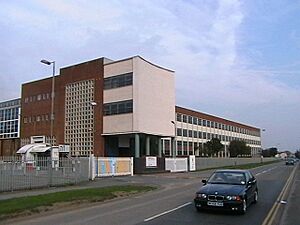
Swindon also became known for car building in the 1950s. Pressed Steel Fisher built a factory that made car body parts. This factory is now owned by BMW.
A new hospital, Princess Margaret Hospital, was built and opened in 1960.
By 1961, Swindon's population reached 91,775. This led to more expansion towards the east, creating areas like Dorcan, Eldene, and Covingham.
The town center underwent a big redevelopment. Old houses were cleared to make way for new shops. The town center became pedestrian-friendly, meaning vehicles were restricted.
Swindon's role as a major railway locomotive builder ended in 1962. However, in 1967, the retailer WH Smith moved its book distribution center to Swindon, taking advantage of its central location. Other companies followed in the 1970s.
In 1969, Swindon Town F.C. achieved its greatest success, winning the League Cup Final against Arsenal at Wembley Stadium!
1970–1990: From Railways to Offices

The M4 motorway opened in 1971, giving Swindon two motorway junctions (15 and 16). In the town center, smaller family shops were replaced by large chain stores. The Wyvern Theatre was also built.
In 1972, the Princess Margaret Hospital finally got a proper accident and emergency unit.
Large companies like Burmah Oil and Hambro Life Assurance (later Allied Dunbar) built their headquarters in Swindon during the 1970s.
In 1974, Swindon merged with the Highworth Rural District to become the Borough of Thamesdown. The new authority built the Brunel shopping center and the Oasis leisure center in 1976. The David Murray John Tower, a tall landmark, was also built as part of the shopping center.
In the 1980s, Swindon expanded west, creating the area now known as West Swindon. The first out-of-town shopping center was built here.
The GWR Works finally closed in 1986, marking the end of an era. The Wills tobacco factory also closed in 1987.
1990–2010: Continued Expansion
On April 1, 1997, the area became known again as the Borough of Swindon.
During the 1990s, the town expanded northwards, with 10,000 new houses built in communities like Abbey Meads and Taw Hill. In the 2000s, more residential areas like Oakhurst and Redhouse were developed.
In 2002, the New Swindon Company was formed to help improve the town center. In 2010, Forward Swindon was created to help with economic growth and property development in the town.
See also
- Borough of Swindon
- Swindon Works
- Swindon Steam Railway Museum
- Goddard family
- History of local government in Swindon
- History of Wiltshire


